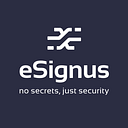We have to go back to 2004 to get to the beginnings of what today is the eSignus project. In the search for a solution to the repudiation of transactions carried out in the digital environment, an investigation is carried out in the IUMA, which concludes with a patent focused on online security for the financial sector. The patent describes a device with the size of a calculator, which reads the transaction from the monitor of a PC and then signs that transaction on that secure device. The idea behind it was to ensure that the transaction could only have been signed by the user who owned the device.
In 2004, neither online banking nor online sales had the development they have today, but there were already problems with the repudiation of transactions and user distrust was an important factor for the growth of these online environments.
In 2012, Ingeniería Electrónica Canaria, with José Ramón Sendra in charge, decided to carry out an R&D project with CDTI funds, the objective of which was to develop a technology that would both solve the repudiation problems that were not resolved by the initial solution and achieve a device format that would facilitate adoption by the end-user. The budget for this project amounted to approximately 1.5 million Euro. It allowed the company to develop the technology and reach a prototype for both hardware and software. The Fábrica Nacional de Moneda y Timbre participates in the project as a supplier of the device’s cryptoprocessor and Plastic Logic as a supplier of the electronic ink screens.
What is built is a device with totally disruptive technology, with a smart card format that has the following characteristics:
- A format similar to that of a credit card, except for the thickness that was not reached in the prototyping stage.
- A BlueTooth antenna.
- A keyboard
- An electronic ink screen.
- The cryptoprocessor of the Spanish electronic ID card.
- A battery.
The goal of this development was to solve the authentication and signature of documents or transactions for online banking users, ensuring the non-repudiation of transactions and the impossibility of fraud or impersonation of the user.
The basis of the technology used is PKI. The non-programmable device generates the pairs of public-private keys, that will serve the user to authenticate or sign transactions in a secure environment, the card. In addition, the fundamental concept of cryptography “What you see is what you sign” was developed through the implementation of the electronic ink screen, which until now had not been implemented in this format or with this concept.
After many meetings with important players in the banking sector, we realized that we had found the solution to a problem that really existed in the market, but the solution hardly fit with the cost structure of this sector. Banks have a high “perceived security” by the user, although fraud in the banking sector exists and affects an increasing number of users. At that time our solution was a significant investment in cost per user that would solve a problem that was covered by insurances but that, on the other hand, involved many departments within the bank, making it difficult to implement. We even explored the certification of the device as a payment method by Visa or Mastercard, which would turn it into a wallet of all the credit and debit cards that the user-owned, but at that time a business model like that of Curve was unthinkable for both international brands and banks.
In 2014 we discovered Blockchain technology in depth. We had heard about Bitcoin, but we had never stopped to analyze the technology behind this new way of exchanging value. We quickly realized that Blockchain technology and the development that had taken place over the years with eSignus had a lot in common. We had developed a Hardwallet without knowing it.
Because Bitcoin was totally incipient, we did not initially make any decision about this potential market. The number of Bitcoin users was residual when compared to the financial sector and we were not sure that it would have the significant growth needed to reorient the project toward this new market.
Parallel to the Blockchain world, smartcard solutions focused on payment methods such as Plastc, Stratos and Coin and even Mastercard and Visa cards with OTP and integrated eInk screens started to appear. From a manufacturing perspective, it was big news. One of the most significant challenges of the project was to implement new flexible circuitry technology and electronic ink displays using massive production processes with meagre failure rates.
Along the way, the eSignus project was frozen in development, but both José Ramón Sendra and I kept the attention in the banking sector and in the advance of Blockchain adoption. In 2018 we decided to start a new project based on the experience and the technology that we had developed previously.
The number of users in Cryptocurrencies environments is growing significantly and companies are beginning to take seriously Blockchain improving their processes and building new business models. But for Blockchain to become a technology that is massively adopted by both companies and end-users, it is necessary to solve security problems with private keys, usability and speed in signing transactions.
So, here begins our exciting journey in building a new solution called HASHWallet. In this blog, we will tell you, how we are developing it and provide the team and the project updates in future posts.
